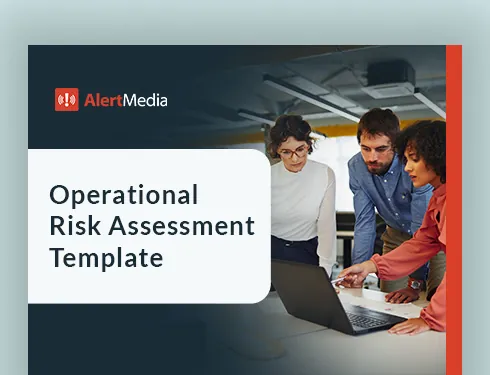
How to Stay Compliant With FFIEC Business Continuity Guidelines
The FFIEC’s business continuity guidelines protect a $22.5 trillion global industry from disruptions that could ripple across economies worldwide.

The financial services sector contributes between 20% and 25% of the global economy, with an estimated market value of $22.5 trillion. Failures within this system can have widespread consequences, including market instability, data loss and fraud, regulatory and compliance violations, reputational damage, and even political and social unrest.
To prevent this, the Federal Financial Institutions Examination Council (FFIEC) has set forth detailed guidelines to help institutions maintain business continuity and operational resilience amid disruptions.
Download Our Operational Risk Assessment Template
What Is the FFIEC’s Role in Governing Financial Institutions?
The FFIEC is responsible for issuing guidelines and standards that financial regulators can use to examine institutions’ soundness and compliance with applicable laws. This interagency body is made up of five separate banking regulators:
- The Federal Reserve Board of Governors (FRB)
- The Federal Deposit Insurance Corporation (FDIC)
- The National Credit Union Administration (NCUA)
- The Office of the Comptroller of the Currency (OCC)
- The Consumer Financial Protection Bureau (CFPB)
Institutions subject to the FFIEC’s guidelines are also regulated by one or more of these agencies. The institutions subject to these standards include:
- National banks and federal savings associations overseen by the OCC
- State-chartered banks and state savings associations regulated by the FDIC
- Credit unions supervised by the NCUA
- Bank holding companies and non-bank financial institutions under the jurisdiction of the FRB
- Consumer financial services providers governed by the CFPB
Each institution must comply with the FFIEC’s standards for safety and soundness, consumer protection, information security, and cybersecurity. These requirements also encompass business continuity, ensuring banks and other financial institutions can continue operations under challenging circumstances.
What Does the FFIEC’s Business Continuity Planning Booklet Cover?
A comprehensive guide on the FFIEC website addresses nearly every aspect of the planning process, from governance and risk assessments to strategies, training, and ongoing improvements. This guide contains nine key sections:
- Business Continuity Management (BCM): This section details the process and outlines the entire BCM program cycle, ensuring that organizations understand how to plan, implement, and manage their business continuity solutions and strategies effectively.
- Business Continuity Management Governance: This section covers the roles and responsibilities of key personnel, outlines succession planning, and establishes auditing standards to ensure robust oversight and compliance.
- Risk Management: Risk management entails a comprehensive process that includes conducting a business impact analysis (BIA) to identify critical business functions, analyze interdependencies, and assess the potential impact of disruptions. It also consists of a risk assessment focusing on identifying risks and evaluating their likelihood and impact.
- Business Continuity Strategies: This section focuses on developing and validating risk-based business continuity strategies. It addresses personnel, processes, technology, facilities, and data protection to ensure resilience and recovery from critical risks, including cyber threats and loss of third-party services.
- Business Continuity Plan: Management should develop detailed business continuity plans (BCPs) tailored to the entity’s size and complexity, incorporating inputs from all business units and covering critical elements such as responsibilities, communication, and recovery procedures. Unlike strategies, which provide broad guidelines for business resilience, the BCP outlines specific procedures and protocols for maintaining operations during disruptions.
- Training: This goes over how management should implement a comprehensive business continuity training program for all stakeholders, aligning with strategies and including exercises, risk assessments, and updates.
- Exercises and Tests: This section emphasizes the importance of practice in ensuring that business continuity procedures meet objectives. It outlines the need for comprehensive plans, various types of exercises (e.g., full-scale, limited-scale, tabletop exercise), and tests to validate system resilience and recovery capabilities.
- Maintenance and Improvement: Maintenance and Improvement involve regular reviews to align the business continuity program with current objectives and address changing risks and technology. Procedures to incorporate lessons learned, like after-action reviews, are also covered.
- Board Reporting: The final section of the FFIEC’s business continuity guidelines focuses on the board’s role. It sets expectations for management’s reporting, regular review, and challenge of reports on BIA, risk assessment, BCP, resilience, and exercise results. It also ensures that updates and discussions are documented in board minutes.
The scope of the FFIEC’s guidance is broad. However, these frameworks make it possible to navigate a crisis with minimal disruption.
FFIEC-Informed Business Continuity Management in Action
Imagine a scenario in which a mid-sized financial institution is hit by a massive cyberattack, causing widespread disruptions across the industry and within the institution’s business processes. The bank faces significant challenges in disaster recovery: Its systems are overwhelmed, customer data is at risk, and transaction services halt. However, the bank was ready because it had rigorously followed FFIEC guidelines.
The organization quickly activated the business continuity plan, built on a comprehensive operational risk assessment and rigorous testing. The crisis management team, trained for such events, efficiently isolated the compromised systems, secured sensitive data, and shifted operations to redundant, geographically dispersed data centers. They connected with third-party service providers to ensure continued support or moved to alternative service providers as needed. Thanks to its preparedness, the bank restored full functionality within hours rather than weeks or months.
Of course, this scenario isn’t just hypothetical, and it doesn’t just apply to cyberattacks. It was vividly illustrated by Charles Schwab’s response to the COVID-19 pandemic. In an episode of The Employee Safety Podcast, Michelle Shooting, Managing Director of Business Continuity and Incident Management at Schwab, detailed how their business continuity strategy, guided by FFIEC principles, played a crucial role in overcoming the pandemic’s challenges.
As regulations evolved to accommodate the shift from on-site to remote work, Schwab had already positioned itself advantageously by transitioning approximately 95% of its workforce to telecommuting. This massive change involved equipping employees with the necessary technology, such as laptops and internet access, reflecting a preemptive alignment with FFIEC’s guidelines on maintaining operational resilience through comprehensive planning.
Shooting emphasized the importance of adapting to local regulations and safety measures, noting that Schwab had to monitor and adjust to varying state and county-level restrictions, a critical aspect of their business continuity efforts. This adaptability was essential in maintaining operations while adhering to new capacity limits and health guidelines.
The pandemic introduced new complexities, such as ensuring the availability of telecommunications infrastructure to support a remote workforce. Schwab’s response involved continuous monitoring and reevaluation of its processes, embodying FFIEC’s emphasis on regularly updating and improving business continuity plans. Shooting noted, “The pandemic has been a perfect storm of challenges, with market volatility and natural disasters all occurring simultaneously, pushing us to continuously improve our programs and processes.”
Overall, Schwab’s proactive approach to adapting its business continuity plan—rapidly transitioning to remote work, staying informed on regulatory changes, and continuously improving its response strategies—exemplifies how aligning with FFIEC guidelines can help organizations remain resilient.
How to Maintain FFIEC Business Continuity Compliance
While the FFIEC business continuity management booklet is extensive, the most important aspects are the components you would tackle in any preparedness or response plan: crisis management, communication, governance, training, and documentation.
Crisis management
Organizations must be prepared to handle emergencies, outages, natural disasters, and other disruptive events through well-defined strategies and practiced responses. Disasters bring significant changes and uncertainty, so a clear and structured crisis management plan can make a substantial difference.
Begin by conducting a thorough risk assessment to identify and prioritize potential threats. Consider risks such as cyberattacks, natural disasters, or critical supply chain disruptions. By understanding which threats pose the most significant risk and how they might impact your organization, you can tailor your response strategies more effectively. If a key supplier fails, having a backup plan ensures minimal disruption to your operations.
Design your plan to be adaptable. Incorporate modular response strategies that you can adjust based on the severity of the crisis. For example, a minor IT outage might need a quick fix, whereas a major data breach requires a more extensive, multi-faceted approach. Flexible, tiered response options allow your team to react swiftly and efficiently to changing situations.
Finally, keep your plan dynamic by regularly reviewing and updating it. Adapt to new risks and incorporate lessons learned from past incidents. This ongoing refinement ensures that your crisis management plan remains practical and relevant, helping you navigate disruptions confidently.
Communication
Communication was one of the significant factors that Michelle Shooting attributed to Schwab’s recovery following the COVID-19 pandemic. Keeping remote workers apprised of new regulations and changes was vital, though some communications were more urgent than others. They responded by using various communication tools, from email and Slack for everyday updates to SMS and desktop alerts for urgent issues, ensuring that critical information captured the necessary attention.
Shooting explained, “You have to tailor your communication method to the communication. For example, if the issue is regulatory, an email with supporting documents might be appropriate. For something that’s rapidly evolving, frequent updates might be needed. In urgent interruptions or recovery cases, SMS or desktop alerts can capture attention and ensure the message is seen promptly.”
Governance
To build a strong governance structure, start by clearly defining roles and responsibilities. Appoint a dedicated business continuity leader or committee to oversee the entire process. This team should have the authority to make crucial decisions, allocate resources, and manage all aspects of the plan effectively.
Create and enforce policies that steer your business continuity efforts. Review these policies regularly, ensuring they stay aligned with your organization’s goals and any regulatory changes. This proactive approach helps you stay compliant with standards like those set by the FFIEC and minimizes risks. By keeping your policies up to date, you’re better equipped to tackle new challenges and changes in regulations.
Accountability is essential for effective governance. Set up clear reporting lines to senior management and the board of directors. This transparency helps ensure that you are regularly assessing the plan’s effectiveness and any making any necessary adjustments.
Training
Returning to the example Michelle Shooting set at Charles Schwab, Schwab’s approach to training emphasizes the importance of integrated exercises and simulations. Schwab frequently conducts cross-team drills and tabletop exercises, ensuring that all stakeholders are familiar with the business continuity plans and their roles within them.
Shooting noted, “You have to bring people together and have integrated walk-throughs. The more you practice and discuss, the better prepared you’ll be to respond effectively.” By regularly engaging employees in these drills, Schwab helps to build muscle memory and ensure that team members are not caught off guard during actual incidents.
Training should not be limited to specific teams; it should be a comprehensive, enterprise-wide effort. Practicing different scenarios helps employees become familiar with the process and develop the ability to react quickly to evolving situations. This approach ensures that when an incident does occur, the team is prepared and capable of executing the response plan efficiently.
Documentation
All of the above must be documented to remain in compliance with FFIEC’s BCM booklet. This process involves maintaining detailed records of business continuity plan development, program examination procedures, training activities, and crisis management efforts. Regular internal audits and assessments help identify potential gaps and areas for improvement, ensuring that the organization remains aligned with regulatory requirements.
After-action reports (AARs) play a crucial role in this process. Following each drill, simulation, or actual incident, an AAR provides a detailed analysis of the response, highlighting what worked well and what did not. These reports offer valuable insights into how effectively the organization executed plans and procedures and where adjustments may be needed. By systematically documenting and reviewing these reports, organizations can track enterprise-wide improvements over time and address recurring issues.
The Road to Financial Resilience
The FFIEC business continuity framework is vital to safeguarding the global economy. Financial institutions play a significant role in the market, and failures within this sector can have widespread repercussions, turning manageable disruptions into substantial crises. By adhering to the principles outlined in the FFIEC guidelines and implementing a clear, well-structured plan, organizations can ensure resilience and compliance, ultimately protecting their operations and contributing to economic stability.




